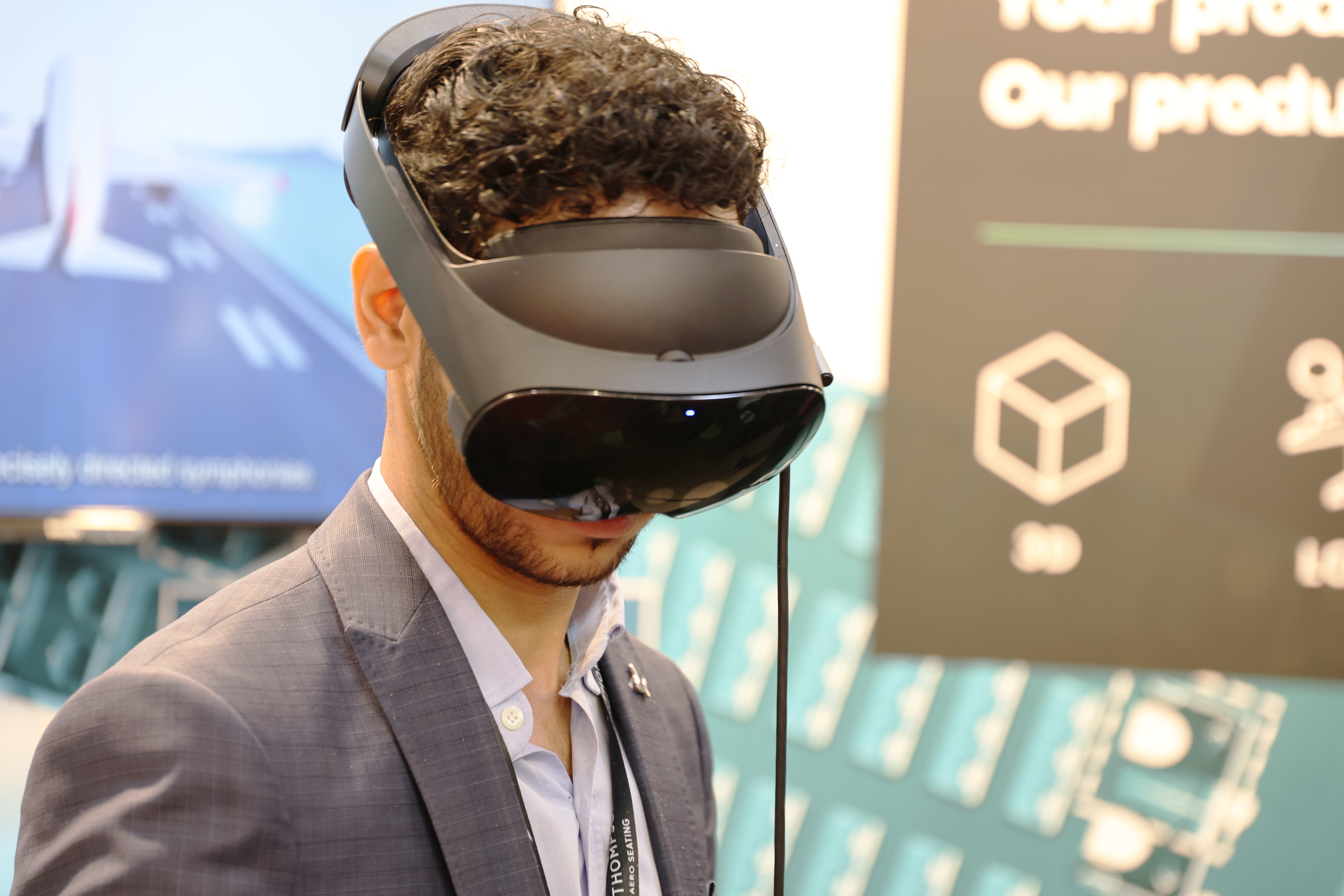Driven by the changing expectations of passengers in an increasingly digital world, air travel is evolving. The nexus of innovative connectivity solutions, entertainment options, and thoughtful interior design is revolutionising air travel.
Airlines that positively harness these trends will achieve both passenger satisfaction and customer loyalty for years to come. Aircraft Interior Expo stands at the forefront of showcasing these developments, and this article offers insights into the key forces reshaping the in-flight experience.
The generational impact on IFEC
Younger generations are reshaping travel expectations and are becoming a powerful force in driving airline spending decisions. These generations, namely Gen Z and Millennials, prioritise seamless connectivity and expect always-on access to information and entertainment, even while soaring thousands of feet above ground.
Given the growing significance of these hugely influential demographics in the air travel market (now accounting for three quarters of passengers, according to Dynata), airlines are making substantial investments in technologies that transform aircraft cabins into connected hubs.

André Valera, Vice President of Business Development, Touch, an AIX exhibitor specialising in in-flight entertainment connectivity solutions, said: “Airlines are actively catering to the tech-savvy, always-connected habits of younger generations onboard through several means. From an in-flight connectivity perspective, prioritising faster, and free, Wi-Fi connectivity to ensure seamless internet access for passengers who rely heavily on their devices for entertainment, work, or socialising.”
Innovations in connectivity and entertainment
Fast and reliable Wi-Fi has moved from a luxury to a staple. As such, the concept of in-flight entertainment is a reality for many major airlines, and is also being explored by short-haul carriers. The carriers that are investing in cutting-edge connectivity solutions are enabling passengers to stream content, connect on social media, and carry our online activities as easily as they would on the ground.
Which begs the question, what’s next for in-flight connectivity and entertainment? As with consumers on the ground, personalised entertainment is the driving factor, with content options becoming more inclusive to appeal to diverse passenger bases.
“Both physical and digital solutions can make all passengers feel welcome.”
Jo Rowan, Associate Director of Strategy at PriestmanGoode
From the latest Hollywood blockbusters to niche documentaries, nowadays there’s something to catch the eye of every traveller. Airlines are partnering with content providers to create custom channels and offer a continuously refreshed collection of movies, TV shows, podcasts, and even games.

Regarding the influence of younger generations on the IFEC industry, Valera has observed a “shift in content preferences”, including an “appetite for gaming”. This has led to Touch investing in exclusive partnerships and licensing agreements to secure popular brands.
Valera continues: “These generations are digital natives, highly connected, and seek seamless solutions in their travel experiences. Social media plays a crucial role as younger travellers share their experiences online, influencing their peers’ travel decisions and shaping airline brand perceptions.
On the ground, innovations in entertainment are constantly being announced, with recent launches from major technology brands centred around immersive experiences such as augmented reality (AR) and virtual reality (VR). Organisations within the airline interiors industry are taking note.
Valera says, “Beyond traditional IFE, we believe immersive experiences such as AR and VR will be tested with more appetite for risk, as well as gamification, to provide engaging alternatives to screen-based entertainment and combat screen fatigue.
We are also seeing airlines and several vendors exploring advanced options like voice and gesture control, not only for convenience but also for hygiene and accessibility, crucial factors for the health-conscious younger demographic.”
A heavy emphasis on instant, high-quality internet requires a reliable network to support it. Hughes Network Systems, an AIX exhibitor, is a leading provider of satellite internet and other satellite-based network solutions. Leveraging several technologies, including GEO and LEO satellites, they provide fast, reliable in-flight Wi-Fi to airlines.
Reza Rasoulian, Vice President at Hughes, said that the demand for fast, reliable, and always-available connectivity is high: “We’re seeing airlines report that passengers are seeking an experience that mirrors the living room. That means uninterrupted and fast connectivity.
Our customers are always looking to introduce the latest innovations to their passengers, including AR, gaming, and such which can be a demanding technology, bandwidth-wise, and requires low latency.
Addressing the in-flight needs of diverse travellers
Meeting the needs of passenger demographics is key to a successful airline strategy. Beyond younger generations, airlines must make specific allowances for the needs of business travellers, leisure passengers, and families.
Jo Rowan, Associate Director of Strategy at PriestmanGoode, understands the challenges of satisfying a diverse passenger base.
Rowan explains, “While younger generations crave tech-driven experiences, older demographics may have different preferences. Striking a balance between these contrasting needs is essential for ensuring a positive experience for all travellers.
This challenge is compounded when you separate passengers into two groups, business, and leisure. It’s all about striking the right balance between creating a space that offers valuable productivity time, and a relaxing environment for those that wish to switch off. Every detail needs to be considered.”
For business travellers, in-flight time is seen as space for valuable productivity. Consequently, airlines are looking for cabin interior design and services with this in mind. Features like reliable Wi-Fi connections, secure video conferencing functionality, and dedicated workspaces allow these travellers to maintain their on-the-go workflow from the skies.
“Passengers are seeking an experience that mirrors the living room. That means uninterrupted and fast connectivity.”
Reza Rasoulian, Vice President at Hughes
Airlines are looking to AI and machine learning (ML), as Valera explains: “We utilise partnerships with content usage data providers like Parrot Analytics to gather insights into passenger preferences and behaviours. Additionally, performance data collected from the IFE systems we operate on behalf of our airline customers is feeding our AI/ML models, allowing us to curate personalised content recommendations tailored to the specific needs and interests of each passenger segment, including business and leisure travellers.”
It’s not only through software that the in-flight entertainment experience can be optimised for business passengers, as Rowan explains.
“With regard to physical space within the cabin, designers consider all aspects of the interior. This includes providing options for noise-cancellation, privacy screens, and enhanced access to productivity tools, such as screen mirroring. This allows business travellers to focus on work or simply unwind without unnecessary distractions.”

Accessibility options
A focus on accessibility is paramount to a satisfying passenger experience for everyone. Inclusive design in onboard entertainment systems is becoming more relevant, with options like closed captioning for the hearing impaired, audio descriptions for the visually impaired, and easy-to-navigate interfaces essential for user-friendliness across the board.
PriestmanGoode advocates for more inclusive cabin spaces, as part of the consortium working on the innovative “Air 4 All” concept back in 2021, a seating system that allows powered wheelchair users to remain in their own wheelchairs for the entire journey.
Rowan explains how in the pursuit of innovation, inclusivity and accessibility must remain paramount: “Technology can serve as a powerful tool. In looking ahead to a more inclusive future within the aircraft interior industry, both physical and digital solutions can make all passengers feel welcome.
Haptic systems can enhance the travel experience with hearing impairments, while digital solutions can allow passengers with customised settings empower those with diverse needs. Our Air 4 All concept exemplifies our commitment to inclusivity by allowing powered wheelchair users to remain in the chairs throughout the flight, eliminating the need for transfers between a personalised wheelchair and a seat that’s not ergonomically suited for them.”
“Social media plays a crucial role as younger travellers share their experiences online.”
André Valera, Vice President of Business Development, Touch
While physical solutions can take years to implement, digital innovation comes at a quicker pace. Touch is actively promoting various accessibility features in in-flight entertainment systems, according to Valera:
“We want to ensure all passengers can enjoy entertainment offerings. That includes adjustable font sizes, contrast settings, and audio description and close captioning, while intuitive interfaces assist those with hearing or mobility impairments. Our recent partnership with Delta Airlines has led to the carrier creating a more accessible passenger experience by including close captioning on all titles onboard.”
Challenges and considerations
While the potential for innovation in aircraft interiors is vast, there are challenges airlines and design firms must navigate to successfully implement these changes. Balancing passenger expectations with practical constraints is crucial. Integrating advanced technology requires careful consideration of space limitations, weight restrictions, and stringent safety regulations. Additionally, the long development timelines associated with aircraft design necessitate creating solutions that remain relevant and beneficial for years to come.
Looking ahead, the future of aircraft interiors will undoubtedly be shaped by the evolving demands of younger generations. Their emphasis on seamless connectivity, personalised experiences, sustainable and accessibility-forward practices demand a dynamic and innovative approach from airlines, suppliers and design firms alike.
By embracing these trends while addressing the associated challenges, the industry can pave the way for a future where air travel is not just comfortable and efficient, but also inclusive, catering to the diverse needs of all passengers.


